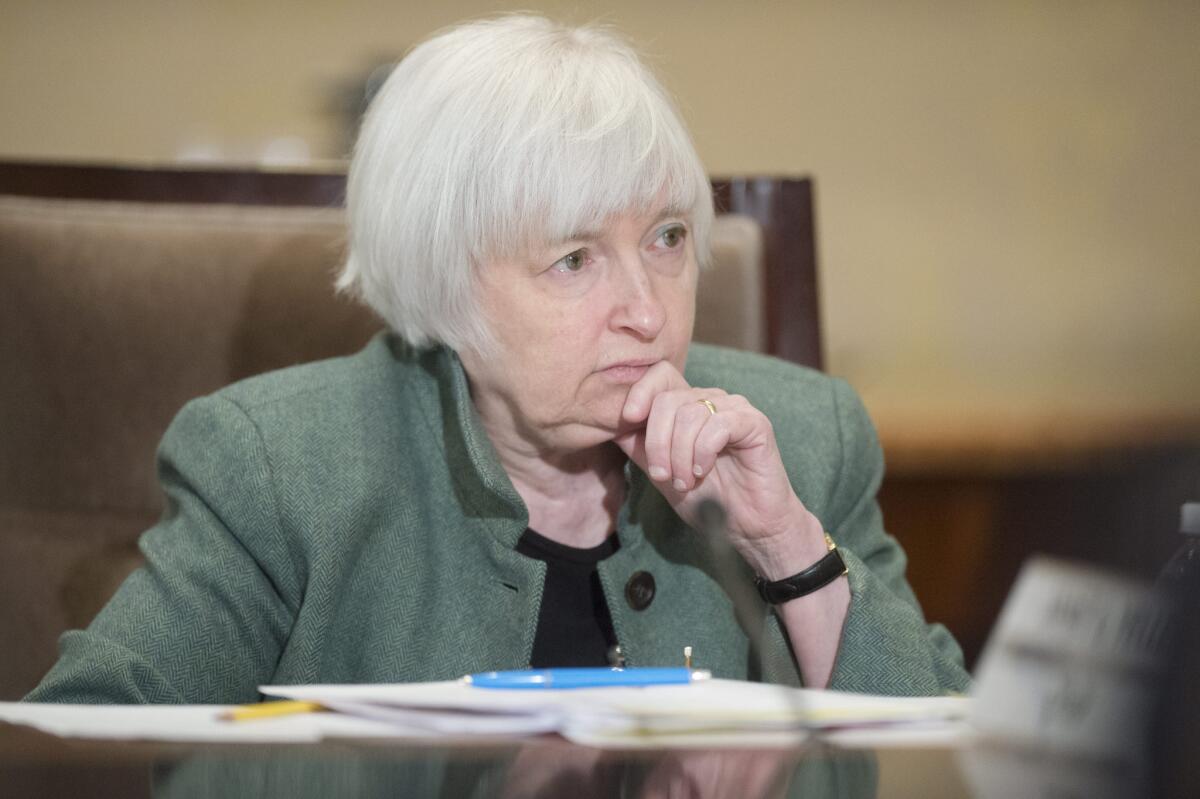What to expect from the Federal Reserve meeting and Janet Yellen’s news conference

Federal Reserve Chairwoman Janet L. Yellen attends an open meeting of the Board of Governors of the Federal Reserve System in Washington on March 4.
- Share via
Reporting from Washington — Analysts and investors would be shocked if Federal Reserve policymakers announced an interest rate hike on Wednesday — and throwing a surprise party for financial markets is the last thing central bank officials want after a turbulent start to the year.
Global stock indexes have stabilized in recent weeks and a mostly upbeat U.S. jobs report has eased recession fears. So Fed Chairwoman Janet L. Yellen and her colleagues are widely expected to wait a while longer before enacting the next hike in the benchmark federal funds rate.
Having failed to signal a hike was coming this week, the Fed needs to “kick the can down the road,” said Greg McBride, chief financial analyst for Bankrate.com.
“If the Fed is going to raise rates, everybody’s got to know they’re going to raise rates,” he said.
Fed policymakers nudged up the rate by 0.25 percentage points in December, ending seven years of keeping it near zero in an unprecedented attempt to boost the economy.
At the time of the increase, a majority of the Fed’s 17 policymakers projected that there would be four more 0.25-percentage-point hikes this year.
Analysts expected those to coincide with Yellen’s quarterly news conferences — in March, June, September and December — so she could explain the Fed’s rationale for the increases.
But a couple of weeks after the December rate hike, financial markets in the U.S. and worldwide began tumbling amid concerns about economic growth in China and the rest of the world.
At their January meeting, Fed officials said they were “closely monitoring global economic and financial developments” and offered no signal that another rate hike was coming soon.
In speeches the past few weeks, Yellen and others haven’t deviated from that strategy, reducing already-low expectations for a March rate hike.
Now the Fed’s monetary policy statement, to be released at 11 a.m. Pacific time after a two-day meeting, and the news conference by Yellen 30 minutes later will offer a chance to start laying the groundwork for possible action this spring.
Here’s what to expect.
Spring rate hike in the offing?
Assuming they hold off on a rate hike this month, Fed officials have a few ways they can signal that one could be coming soon.
One is to refer to the balance between the risks that the economy will exceed their expectations and that it will fall short.
In December, Fed officials said the risks were balanced, which helped justify a rate hike. In January, the statement simply said that Fed officials were monitoring global economic and financial developments to assess their effect on the balance of risks.
The lack of any determination on the balance of risks indicated that the Fed wasn’t close to enacting another rate hike.
A return to language indicating risks are balanced or “nearly balanced” would indicate that a rate hike is approaching.
Yellen also will have a chance to emphasize the view of upside and downside economic risk during her news conference.
Connect the dots
Another key rate hike indicator will be contained in the Fed’s quarterly economic projections, which also will be released on Wednesday.
Policymakers put dots on a graph to illustrate the anticipated federal funds rate at the end of the next four years and in the longer run.
Assuming the Fed enacts only small, 0.25-percentage-point hikes, as they have signaled, the so-called dot plot gives a sense of how many rate hikes officials anticipate this year.
Two or three more hikes would probably mean the next one would come this spring if they were to be spaced evenly through the rest of the year.
“If the economy doesn’t significantly worsen …. it would be reasonable to expect one or two more rate hikes this year,” said Bart Van Ark, chief economist at the Conference Board. He thinks the first of those hikes could come in June.
Expect Yellen to be asked about the dot plot and what it indicates for the next rate hike.
Watching for inflation
A key reason some Fed policymakers have been hesitant about another rate hike is stubbornly low inflation.
Typically, the Fed increases its key interest rate to keep prices from rising too fast as the economy improves. But inflation has been low throughout the recovery. Slow wage growth has been one reason. Falling oil prices have been another.
There have been mixed signals on wage growth. And Fed officials have said they expected the effects of low oil prices to be temporary.
But Fed Vice Chairman Stanley Fischer said in a speech last week that the U.S. could be “seeing the first stirrings of an increase in the inflation rate.”
The Fed’s preferred measure of inflation, based on personal consumption expenditures, picked up in January, the most recent data available.
For the 12 months ended Jan. 31, prices increased 1.3%. And core prices, which include volatile food and energy, rose 1.7%. The Fed wants to see annual inflation of 2%.
What the Fed says in its statement about inflation, and how Yellen amplifies that when pressed on the question, will be a strong indicator of whether policymakers are closing in on an interest rate hike this spring.
Follow @JimPuzzanghera on Twitter
ALSO
Charter-Time Warner Cable deal headed for FCC approval
Core consumer prices post biggest 12-month increase in nearly three years
Chinese hotel firm buys Yamashiro property in Hollywood Hills
More to Read
Inside the business of entertainment
The Wide Shot brings you news, analysis and insights on everything from streaming wars to production — and what it all means for the future.
You may occasionally receive promotional content from the Los Angeles Times.











